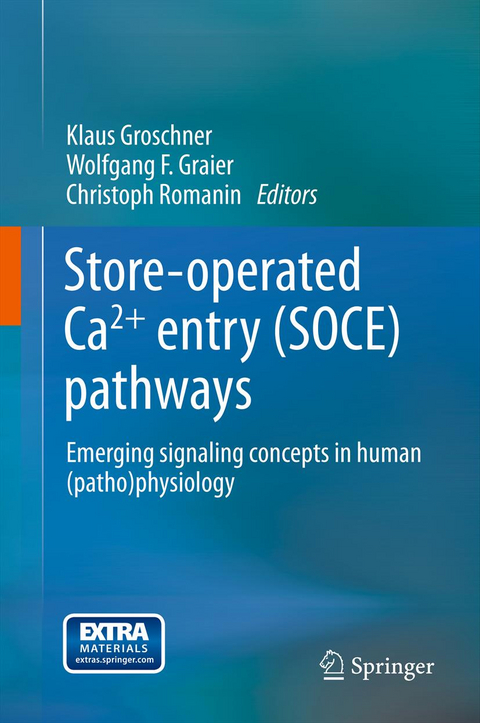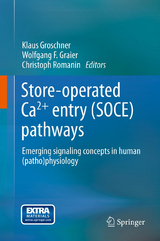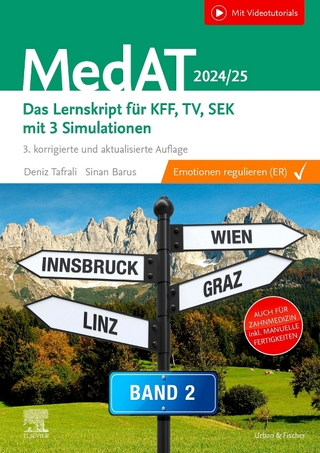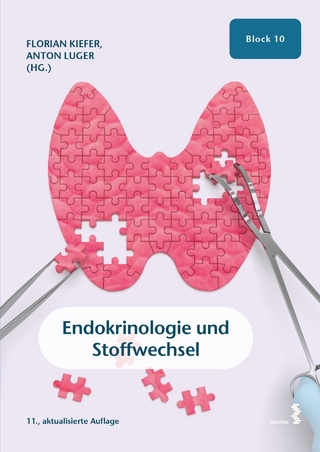Store-operated Ca2+ entry (SOCE) pathways
Springer Wien (Verlag)
978-3-7091-0961-8 (ISBN)
Store-operated Ca2+ entry (SOCE) serves to control essential functions throughout the human body and represents a novel and attractive target for therapeutic intervention. This book provides an extensive overview of the role of SOCE pathways in Molecular Physiology and Cell Biology, as well as their clinical significance. (Patho)physiological principles and emerging therapeutic strategies are delineated in a way that is valuable both for the education of graduate students in advanced Cell Biology/Molecular Physiology and for the promotion of innovative research and developments in the clinical/therapeutic fields. A comprehensive, clear and elaborate representation of current concepts is provided, including a pathophysiological section arranged in a tissue/organ/system-oriented manner. The book is intended for basic researchers specializing in cell signaling, ion transport, or pharmacology, as well as biomedical scientists and clinicians with a focus on immunology, neurology or cardiology.
Prof. Klaus Groschner studied Pharmacy at the School of Pharmacy, University of Graz, Austria. He completed his PhD studies at the Department of Pharmacodynamics in Graz and received part of his postdoctoral education at the University of Miami, Florida, USA, studying electrophysiology and cell biology. In 1990 he became an Assistant Professor at the Department of Pharmacology and Toxicology and received his Habilitation in Pharmacology and Toxicology along with promotion to Associate Professor in 1993. Until 2011 he was head of a research unit for Physiology and Pharmacology of Membrane Transport at the Institute of Pharmaceutical Sciences at the University of Graz. Since 2012 he is Full Professor and Chairman at the Institute of Biophysics at the Medical University of Graz. Prof. Wolfgang F. Graier studied Pharmacy at the University of Graz, Austria and received his PhD in Pharmacology at the Department of Pharmacology and Toxicology, University of Graz. In 1993 he was a postdoctoral research fellow, analyzing physiology and membrane biophysics at the Dalton Cardiovascular Research Center, University of Missouri, Columbia, USA. In 1994 he became an Assistant Professor at the Department of Medical Biochemistry, University of Graz and Professor in Biochemical Pharmacology at the Medical Faculty in 1995 (Habilitation), and in Physiology in 2001. Since 2006 he is head of the Research Unit for Molecular and Cellular Physiology at the Medical University of Graz. Since 2009 he is Full Professor for Molecular Biology and Chairman of the Institute of Molecular Biology and Biochemistry at the Medical University of Graz.
Preface (C. Romanin, W. F. Graier, K. Groschner).- SECTION 1: SOCE - Fundamental mechanistic concepts.- Introduction (J. W. Putney).- 1.1 The STIM-Orai pathway.- Structural insights into Ca2+ sensing by stromal interaction molecules (P. B. Stathopulos, M. Ikura).- 1.2 The STIM-Orai pathway. Orai, the pore-forming subunit of the CRAC channel (P. G. Hogan).- 1.3 The STIM-Orai pathway. The interactions between STIM and Orai (R. Schindl, M. Fahrner, M. Muik, I. Derler, C. Romanin).- 1.4 STIM-TRP pathways. The STIM1/Orai/TRPC channels multiple Ca2+ influx complexes (J. H. Hong, M. S. Kim, K. P. Lee, J. P. Yuan, S. Muallem).- 1.5 STIM-TRP pathways. Function and regulation of TRPC1: Contribution to Ca2+ entry activated by store depletion (I. S. Ambudkar, K. T. Cheng, H. L. Ong, X. Liu).- 1.6 Microdomain organization and the role of second messengers. Microdomain organization of SOCE signaling (C. Moreno, L. Vaca).- 1.7 Microdomain organization and the role of second messengers. Store-operated Ca2+ entry: Endogenous messengers and mediators (V. M. Bolotina).- SECTION 2: SOCE - Crosstalk between organelle and cellular compartments.- Introduction: Ca2+ signaling and gene regulation: An introduction (A. B. Parekh).- 2.1 New aspects of the contribut
ion of ER to SOCE regulation. The role of the ER and ER-plasma membrane junctions in the regulation of SOCE (H. Dingsdale, L. Haynes, G. Lur, A. Tepikin).- 2.2 New aspects of the contribution of ER to SOCE regulation. The contribution of SERCA to the regulation of SOCE (J. García-Sancho, M. T. Alonso).- 2.3 New aspects of the contribution of ER to SOCE regulation. TRPC proteins as a link between plasma membrane ion transport and intracellular Ca2+ stores (A. Bavencoffe, M. X. Zhu).- 2.4 The role of mitochondria in the activation/maintenance of SOCE. Store-operated Ca2+ entry and mitochondria (A. Spät, G. Szanda).- 2.5 The role of mitochondria in the activation/maintenance of SOCE. Local regulation of plasma membrane channels by mitochondria (N. Demaurex, M. Frieden).- 2.6 The role of mitochondria in the activation/maintenance of SOCE. The contribution of distinct mitochondrial Ca2+ uptake mechanisms, mitochondrial motility and location to store-operated Ca2+ entry (R. Malli, W. F. Graier).- 2.7 Tissue specificity. The role of nanospaces between the organellar membranes in smooth muscle Ca2+ signaling (N. Fameli, A. M. Evans, C. van Breemen).- 2.8 Tissue specificity. SOCE - implications for Ca2+ handling in endothelial cells (L. A. Blatter).- SECTION 3: SOCE - Molecular and cellular (patho)physiology.- Introduction (J. A. Rosado).- 3.1 Immune system. SOCE mediated by STIM and Orai genes in immune function and disease (S. Feske).- 3.2: Cardiovascular system. STIM1/Orai1-mediated store-operated Ca2+ entry in cardiovascular disease (R. K. Motiani, M. Trebak).- 3.3: Cardiovascular system. TRPC/Orai-containing channels, Na+/Ca2+ + exchanger and Ca2+ handling in hypertension (V. A. Golovina).- 3.4: Cardiovascular system. SOCE and TRPC/STIM/Orai signaling in cardiac myocytes (H. Watanabe, T. Ohba, H. Ito).- 3.5: Cardiovascular system. SOCE as a determinant of cardiac pacemaker activity (D.G. Allen, Y. K. Ju, J. Liu, M. S. Imtiaz).- 3.6: Cardiovascular system. SOCE and Ca2+ handling in platelet dysfunction (J. J. Lopez, G. M. Salido, J. A. Rosado).- 3.7: Cardiovascular system. Store-operated Ca2+ entry in endothelial pathophysiology (K. Groschner, M. Poteser).- 3.8: Nervous system. Pathophysiological perspective of neuronal store-operated Ca2+ signaling (S. Bollimuntha, B. Pani, B. B. Singh).- 3.9: Skeletal muscle. Store-operated Ca2+ entry and STIM/Orai signaling in skeletal muscle (J. A. Stiber, P. B. Rosenberg).- 3.10: Skeletal muscle. Store-operated channels and Ca2+ handling in muscular dystrophy (U. T. Ruegg, G. Shapovalov, K. Jacobson, J. Reutenauer-Patte, H. Ismail, O. M. Dorchies, P. Avdonin).- 3.11: Reproductive system. Store-operated Ca2+ entry in germ cells - role in egg activation (Z. Machaty, C. Wang, K. Lee).| Erscheint lt. Verlag | 15.3.2012 |
|---|---|
| Zusatzinfo | XXII, 482 p. With online files/update. |
| Verlagsort | Vienna |
| Sprache | englisch |
| Maße | 155 x 235 mm |
| Gewicht | 880 g |
| Themenwelt | Medizin / Pharmazie ► Studium |
| Schlagworte | Calcium • Calcium Entry • Calcium / Kalzium • Calcium Signaling • Kardiologie • Molekularmedizin • ORAI Pathway • STIM Pathway • Transient Receptor Potential TRP |
| ISBN-10 | 3-7091-0961-2 / 3709109612 |
| ISBN-13 | 978-3-7091-0961-8 / 9783709109618 |
| Zustand | Neuware |
| Haben Sie eine Frage zum Produkt? |
aus dem Bereich




